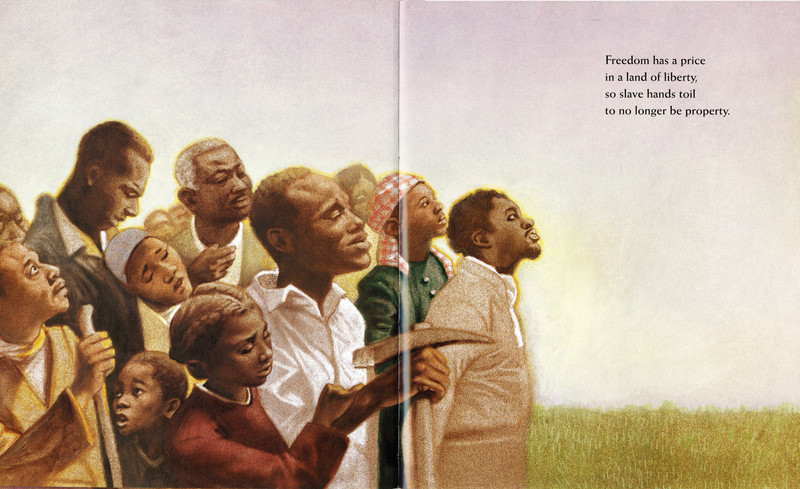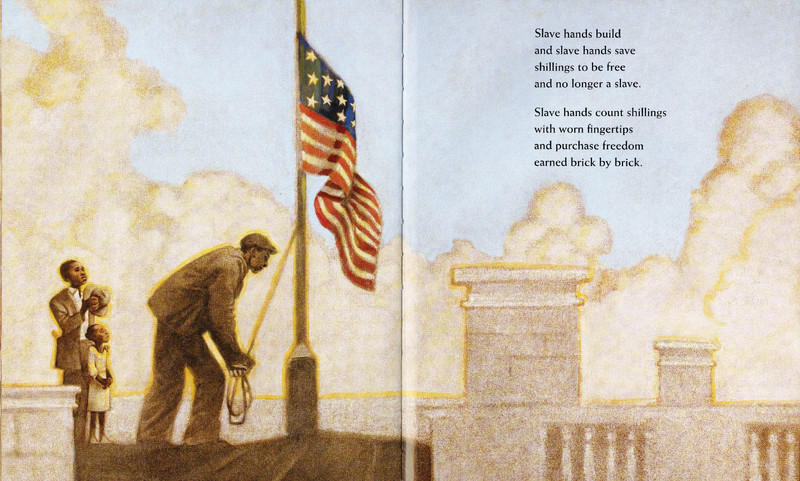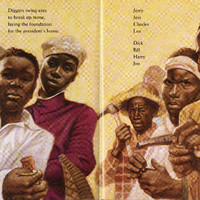Brick by Brick
Item- Title
- Brick by Brick
- Description
-
Brick by Brick tells the story of the people who built the White House (1792-1800), showing cooperation between enslaved and free persons, and between black and white artisans. Production stories about historically significant structures—such as estate houses, castles, bridges, engineering wonders, government buildings, and churches—have their roots in early travel literature for children. By the mid-eighteenth century, educational travel literature included sketches about the major historical landmarks that children might tour with their families, alongside other sites like factories, shipyards, and natural wonders. By the twentieth century, improvements in book illustration and affordable printing supported a resurgence of production stories about buildings, marked by David Macaulay’s Caldecott honor book, Cathedral (1973).
The construction industry is not responsible for the expansion of chattel slavery in the same way as cotton or sugar. Yet production stories about buildings remain political because they are symbolically significant embodiments of the narratives people tell about their nation. Emotional investment in old buildings leads to debates over what stories they should reveal for visitors. For instance, plantation houses attract visitors who want to learn accurate information about the lives of enslaved persons, but also visitors who expect a nostalgic reenactment of Antebellum America. Federal monuments celebrate the achievements of early Americans, which include slave owners such as George Washington and Thomas Jefferson. Production stories about major buildings thus have to contend with questions of national identity. And like other production stories, they have always been deeply political, requiring the author to decide whether to reveal to children the possibly violent history of how a building was made and for what purpose. Even the earliest sketches about famous buildings in children’s books touched upon whether the pyramids were built by slaves, or celebrated a famous female general who once defended her castle, or explained religious wars that destroyed a family—historical events that resonated with present-day controversies.
Brick by Brick centers more on the people who built the White House than on the building itself. In the first spread shown here, the text suggests names for the unnamed workers. Photorealistic illustrations provide strongly individualized facial expressions that frankly acknowledge the exhaustive work, the participation of enslaved children, and the violence used to coerce enslaved persons. In picture after picture, enslaved black workers meet the reader’s gaze. Some of them look angry, others disheartened, and some hopeful. The mixed expressions heighten reader identification and humanize the many people involved in the work, only some of whom were allowed to keep a portion of their wages, which they used to buy their freedom. When the White House is finished, the illustration focuses on the builders themselves, with the White House itself outside of the frame. For their part, the builders look in several directions, some looking at one another. Centering the people, not the building, is an important authorial choice because so many production stories minimize the faces and identities of people at work, focusing instead on a famous architect or engineering feat.
The closest readers get to the White House is in the final spread. A contemporary African American family atop the White House roof tends a flag ambiguously posted at half mast, as if in mourning for those who died without their freedom. The view is difficult to identify, since we are level with the family. One intriguing way to interpret the image is that viewers are looking at this scene from across the National Mall, while standing inside the National Museum of African American History and Culture, which was under construction when Brick by Brick was published. From this perspective, the book mourns and celebrates the construction of two quite different buildings, placed opposite to one another. - Creator
- Smith, Charles R., Jr.
- Contributor
- Cooper, Floyd (illustrator)
- Date
- 2013
- Subject
- production story
- construction work
- contemporary children's literature
- Rights
- Text copyright 2013 by by Charles R. Smith, Jr. Illustrations copyright 2013 by Floyd Cooper. Text and image used under fair use.
- Identifier
- University of Illinois Library, Urbana-Champaign, Call Number: Q. S.975.302 Sm511b
- Bibliographic Citation
- Smith, Charles R., Jr. Brick by Brick. Illustrated by Floyd Cooper. New York: Amistad, 2013.





